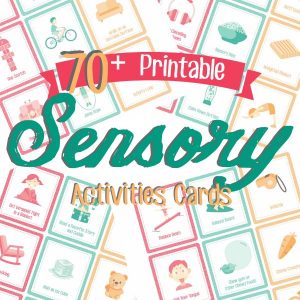Inside you’ll find: Explanations of how different variables can cause sensory issues in some counter intuitive ways.
Kids love to make liars out of their parents.
Just when you think you have them figured out, they’ll do the total opposite.
This is especially true for kids with big sensory needs.
You’ll see a pattern of behavior that will have you convinced they’re an avoider, then BAM!, they do something that is clearly a seeker tendency.
Reactions to sensory input can change from season to season, or even from one day to another.
It can be so baffling when your kid goes from hating anything sticky on Tuesday, to playing in a mud puddle on Wednesday.
What gives?
Scroll to the bottom for a VIDEO I recorded about this topic!
Sensory Seeker and Avoider Labels are Too Simplistic
The primary reason parents are confused by sensory behavior stems from a misunderstanding about avoiders and seekers.
Avoiders and seekers are NOT the two different types of sensory kids.
There are actually a large assortment of combinations, because kids can be seekers or avoiders in EACH of the different senses.
Your child might be a tactile avoider, an oral sensory seeker, a vestibular avoider and a proprioceptive seeker or any other combination!
See how complicated it can get?
And remember, sensory input rarely comes in only one isolated form.
Example: Swings are a great activity to help proprioceptive seekers, but it also is coupled with tons of vestibular input, so that might be met with resistance from vestibular avoiders that still crave proprioception.
Because of the complicated nature of sensory needs, it’s so important to have an occupational therapist involved. They are the ones that will help you sort through all the labels. If they oversimplify things, ask for further clarification so you aren’t in the dark about your child’s specific needs.
P.S. If you’re wondering what is THE most effective sensory activity to prevent meltdowns with your unique child, take this quick, free, informative quiz. I created it to help you get started in the right direction!
The Sensory Bank
Another reason sensory behavior can be unpredictable, rests in the fact that sensory input is not an isolated event.
All day every day, your child is receiving sensory input; some of it calming, some of it very upsetting to their bodies.
So one morning your child may tolerate putting on their jeans, and the very next day be repulsed by the same pants.
It’s the same sensory input, but the hours before may have been drastically different.
Think of your child’s body as a sensory “bank”.
Some days your child gets lots of beneficial sensory input from playing outside or doing specific sensory activities.
Their brain is getting what it needs and can regulate fairly well when an uncomfortable sensory situation comes up. Their bank is quite full, so a small withdrawal won’t be the end of the world.
Another day is full of disturbing and annoying sensory input: an itchy tag, a nauseating car ride, too much noise, etc.
Your child is doing their best to keep their composure and continue to function in the world around them. But their sensory “bank” keeps having “money” taken out and eventually, goes bankrupt. That’s when we see the meltdown.
So sometimes it might seem like a straw broke the camel’s back, but don’t forget to look at the whole picture of the day, and even the week!
Sensory input is always adding up, or taking away from the sensory “bank”.
Too Many Variables
If you lived in a sterile controlled lab, you MIGHT be able to predict your child’s sensory behavior, but this is the real world.
There is literally sensory input coming at your child from all sides!
Let’s say your 5 year old is having a meltdown every time they are in the car. It could be visual (sun in the eyes), tactile (the seat belt is bothersome), auditory (the high pitched sound of the tires), or vestibular (inner ear issues that cause disorientation) or who knows what else.
You have to become a bit of a sensory detective, guessing what “small” sensory factor might be contributing to their discomfort.
Remember to ask good questions of your child. They may respond with big emotions (“I just hate the car! I’m scared, mad, bored etc.”) , but help them pinpoint what their body is feeling. (“What does your skin feel when you’re in your seat? How do your ears feel? etc”)
Don’t give up. While sensory needs are seemingly unpredictable, you can get clarity and gain confidence!
See the other resources we’ve created for you below.
Have more questions??? Check out this wildly popular series of Sensory FAQs and become a more confident sensory parent today!
Sensory Parenting 101 will give you the most in depth understanding of all things sensory. You’ll be equipped like never before!
Don’t miss my Facebook Chat with other sensory parents about how SPD keeps us on our toes! Play the video below!










Full Spectrum Mama says
Totally brilliant.
I was JUST having a conversation about this with my son, because I am — typically — an avoider and was about to get a migraine because my “brain gets full/overwhelmed” and he asked why I react so differently if we are both neurodiverse. I explained about this concept, using words like sensitive and less-sensitive; but ALSO explained that I think he is often a “seeker” or seems “less-sensitive” because his system actually is already overwhelmed. make sense?
Anyway, this puts it in a very clear way!
Thanks and love,
Full Spectrum Mama